#been really into dario argento recently if you guys can tell
Text
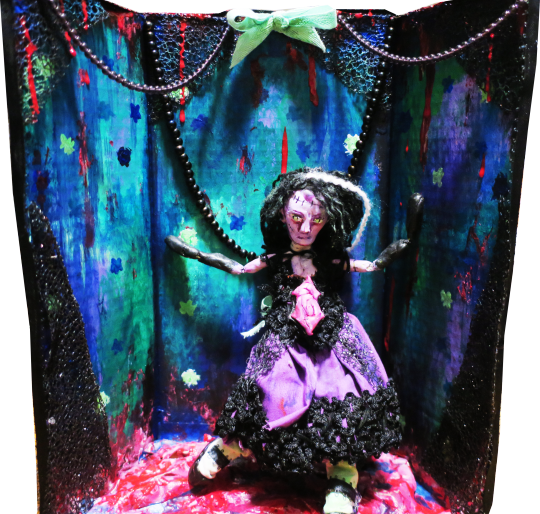


he's the andricon girl
#art#sculpture#oc art#clay sculpture#dolls#art doll#ooak doll#artists on tumblr#been really into dario argento recently if you guys can tell
12 notes
·
View notes
Text
Double Features 2: Splatter, Splicer, Slander, Slasher
Considering the fact that we’re locked down and most folks aren’t going out much, why not settle in on a weekend with double feature. As part of a series of articles, I’ve decided to suggest some titles that would make for an interesting pair. It’s a time commitment like binging a few episodes of a TV show, and hopefully these double features are linked in interesting enough ways that it has a similar sense of cohesion. They also can be watched on separate occasions, but the lesser the distance between them, the more the similarities show. Do it however you want, really. I’m merely a guy on the internet, and that qualifies me for absolutely nothing! Enjoy at your own risk.
This template is back! I wanted to suggest a few more double features, but this time keep them in a specific genre: horror. I love horror movies, and I realized that I hadn’t really given them their due on this here blog, so I wanted to remedy that by showing a lot of love across a lot of different movies. I’ve put together some international movies, some classics, some that are silly, some that are serious, and even a bonus suggestion hidden in one of these blurbs. So without any more ramble in the preamble, here are four new suggested double features.
Note: The pairs are listed in the order I think best serves them being seen.

Hausu & Evil Dead II:
Hausu aka House (not to be confused with 1985 American horror film of the same name) has sort of transcended cult movie status to become a staple of off-center horror-comedy. Directed by recently deceased Nobuhiko Obayashi, the film shows his roots in advertisements with every shot designed for maximum effect, a (still) cutting edge approach in the edit, and a joyous, playful approach to special effects. It’s a gauzy and dreamy romp about a group of schoolgirls who head to the countryside on vacation. While staying at one of their aunts’ house, the supernatural hauntings begin, and heads start to roll (as well as bite people on the butt). It’s the type of movie where the main cast of characters are named Gorgeous, Kung Fu, Melody, Prof, Mac, Sweet, and Fantasy and they each have corresponding character traits. I was lucky enough to catch this at a rep screening at the Museum of Fine Arts a few years ago (further proof that this has gone beyond the cult curio status), and this is absolutely a movie that benefits from having a crowd cheer and laugh along - but it’s fairly easy to find and still has lots of pleasures to be enjoyed on solo watch. I’m pretty much willing to guarantee that if you enjoy it on first watch, you’ll want to share it with others. Now, where does one start when talking about Evil Dead II? Sam Raimi is rightfully as well known for his start in the hair-brained splatter genre fare as he is for his genre-defining Spider-man films. The influence of the Evil Dead movies is nearly unquantifiable, apparent in the work of directors like Edgar Wright, Peter Jackson, Quentin Tarantino, and the Korean New Wave filmmakers like Bong Joon-ho and Park Chan-wook. There’s a reason that the second film of his Evil Dead odyssey is the one that people hold in highest esteem, though. There is an overwhelming gleeful creativity, anything goes, Looney Tunes approach to it that makes the blood geysers, laughing moose heads, and chainsaw hands extend beyond gore and shock into pleasure. It’s been noted over and over by critics and Raimi himself that the Three Stooges are probably the biggest influence on the film, and by golly, it shows. Evil Dead II and Hausu are pure in a way that few other movies can be. Both of these movies are an absolute delight of knowing camp, innovative special effects, and a general attitude of excitement from the filmmakers permeating through every frame. They’re a total blast and, in my mind, stand as the standard-bearers for horror-comedy and haunted house movies.
Total Runtime: 88 minutes + 84 minutes = 172 minutes aka 2 hours and 52 minutes
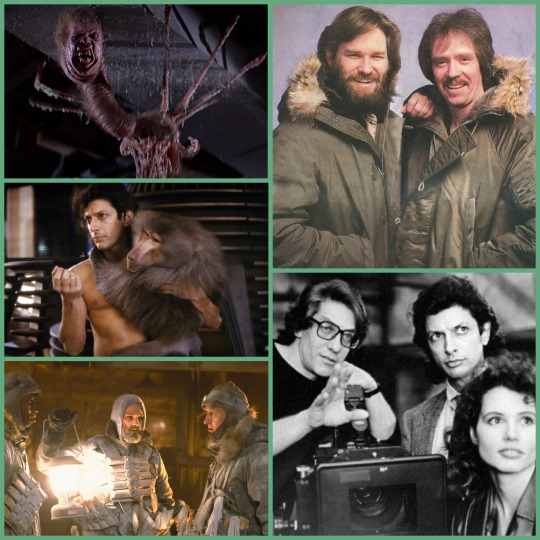
The Thing (1982) & The Fly (1986):
Feel free to roll your eyes as I explain the plots of two very famous movies. The Thing is John Carpenter’s body horror reimagining of Howard Hawks’ The Thing from Another World and the story that was adapted from, “Who Goes There?” by John W. Campbell Jr. The film is centered around a group of men in an arctic outpost who welcome in a cosmic force of shape-shifting annihilation. What ensues is a terrifically scary, nihilistic, paranoid attempt to find who isn’t who they say they are before everyone is replaced with the alien’s version of them. The film is a masterpiece of tone in no small part due to Dean Cundey’s photography and Ennio Morricone’s uncharacteristically restrained score. The real showstopper here, though, is the creature effects designed by Rob Bottin with an assist from Stan Winston – two titans of their industry. There may not be a more mind-blowing practical effects sequence in all of movies than Norris’ defibrillation – which I won’t dare spoil for anyone who hasn’t seen it. The story is so much about human nature and behaviors, that it’s good news that the cast is all top-notch – anchored by Kurt Russell, Keith David, and Wilford Brimley. While The Thing is shocking and certainly not for anyone opposed to viscera, David Cronenberg’s The Fly is the best example of a movie not to watch while eating. Quite frankly, it’s got some of the most disgusting things I’ve ever seen on film. Chris Walas and Stephen Dupuis’ makeup effects are shocking, but the terror is amplified because this builds such a strong foundation of romance in its opening stretch between Jeff Goldblum and Geena Davis in what might be their career-best work. The story is simple: a scientist creates a teleportation device that he tries out himself, but unknowingly does so with a fly in the chamber with him. When he reatomizes on the other end, his DNA has been integrated with the fly. Slowly his body begins to deteriorate, and he transforms into a human-fly hybrid. While this is first and foremost a science-fiction horror film, it’s truly one of the most potent love stories at its center. The tragedy is that the love, like the flesh, is mutated and disintegrated by the hubris of Goldblum’s Seth Brundle. Here are two remakes that – clutch your pearls – outdo the original. They both serve as great examples of what a great artist can bring by reinterpreting the source material to tell their version of that story. The critical respect for Carpenter and Cronenberg is undeniable now, but both of these movies make the case that there are real artists working with allegory and stunning craft in less respected genre fare. It doesn’t take a lot of effort to transpose the thematic weight of the then-new AIDS crisis onto both films, but they both have a hefty anti-authority streak running through them in a time where American Exceptionalism was at an all-time high. If you want to get a real roll going, fire up the ’78 Invasion of the Body Snatchers first to get a triple dose of auteur remakes that reflect the social anxieties of the time and chart from generalized anxiety to individualistic dread to romantic fatalism.
Total Runtime: 109 minutes + 96 minutes = 205 minutes aka 3 hours and 25 minutes
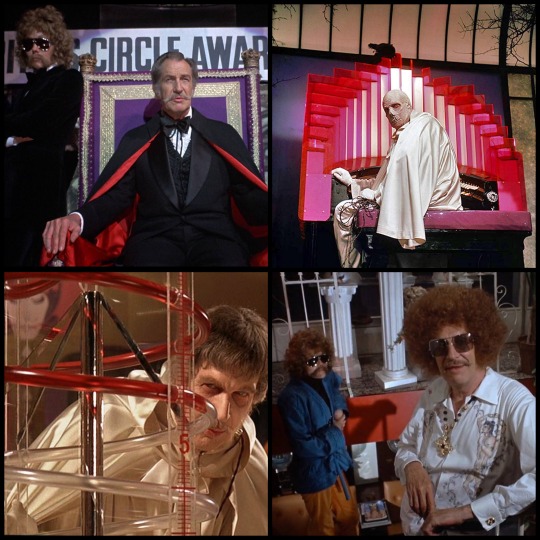
Theatre of Blood & The Abominable Dr. Phibes
That old Klingon proverb that Khan tells Kirk about revenge being a dish best served cold is challenged by these two Vincent Price tales of the macabre. They posit that revenge is best served in extremely convoluted and thematically appropriate predecessors to the Saw franchise. Where Saw trades in shock and extremity, though, these classic horror tales offer an air of panache and self-satisfied literacy. In Theatre of Blood, Price plays a disgraced and thought-dead stage actor who gets revenge on the critics who gave him negative reviews with Shakespeare-themed murder. There’s good fun in seeing how inventive the vengeful killings are (and in some cases how far the writers bend over backwards to explain and make sense of them). It’s a little rumpled and ragged in moments, but Price is, of course, a tremendous pleasure to see in action as he chews through the Shakespeare monologues. Imagine the Queen’s corgis with a chainsaw and you’re on track. Phibes came first and, frankly, is the better of the two. The story is about a musician who seeks to kill the doctors who he believes were responsible for his wife’s death during a botched surgery. The elaborate angle he takes here is to inflict the ten plagues from the Old Testament. I hesitate to use a word that will probably make me come across as an over-eager schmuck, but it really feels best described as phantasmagorical. It’s got this bright, art deco, pop art sensibility to it that’s intoxicating. It also has a terrifically dark sense of drollery - it knows that you can see the strings on the bat as it flies toward the camera. Aesthetically, it feels adjacent to the ’66 Batman show. The music is great and the indelible image of his tinker toy robot band, The Clockwork Wizards, is a personal obsession of mine. Both Theatre of Blood and The Abominable Dr. Phibes feature great supporting turns from Diana Rigg and Joseph Cotton, respectively. Settle in for a devilishly good time and enjoy one of cinema’s greatest vicarious pleasures: getting back at those of criticized or hurt you.
Total Runtime: 104 minutes + 94 minutes = 198 minutes aka 3 hours and 18 minutes
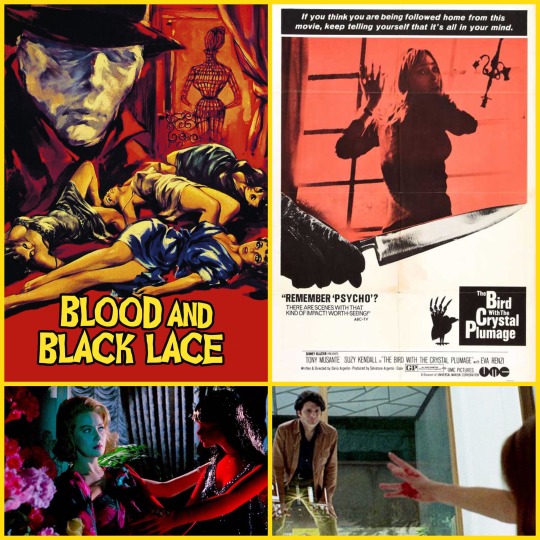
Blood and Black Lace & The Bird with the Crystal Plumage
The final pairing comes from beyond American borders and, to some, beyond the borders of good taste. Mario Bava and Dario Argento are likely the two biggest names in Italian horror, and that’s for very good reason. Bava, who started as a cinematographer, has made loads of movies (even the film which gave Ozzy Osbourne and crew the name their band name) that have tremendous visuals and terrific sense of mood. Argento, probably most famous now for Suspiria, emerged onto the Italian film scene a handful of years later and picked up that baton from Bava to crystallize the dreamy logic puzzles cloaked in hyper-saturated colors. These two films are regarded as quintessential in the giallo genre – named for the yellow covers of the pulp crime fictions that inspired them. As someone who loves the flair that can be applied to make a slasher film stand out amongst their formulaic brethren, I found that the giallo made for a smooth transition into international horror. Blood and Black Lace is a murder mystery that’s as tawdry and titillating as its title suggests. Set in an insular world of a fashion house in Rome, models are being murdered. The plot feels like a necessity in order to create a delivery system for the stunning set pieces that revolve around a secret diary. Bava puts sex right next to violence and cranks up the saturation to create something thrillingly lurid. Six years later, Argento made his first film which has often been credited for popularizing the giallo genre and already is playing around with some of his pet themes like voyeurism and reinterpretation. Built around an early set piece (that stacks up as one of the best in thrillers) in which a man is trapped but witnesses a murder, the film sees said man trying to find the piece of evidence that will make the traumatic killing make sense. Like Bava, it blends sex and violence with tons of flair, including a score by the aforementioned Ennio Morricone. The film is absolutely on a continuum between Hitchcock and De Palma. If you’re looking for a pair of exciting horror/thrillers, or even an entry point to foreign genre cinema, this is an accessible and enjoyable place to start.
88 minutes + 96 minutes = 184 minutes aka 3 hours and 4 minutes
Well, there you have it. Eight movies, and hours of entertainment curated by some guy with no real qualifications. If you’re interested in some more suggestions (in horror and other genres), stay tuned for the next entry in this Double Features series. And if you’re looking for a way to watch these movies, I highly recommend the app/website JustWatch where you can search a title and see where it’s available for streaming or rental. Happy viewing.
Thanks for reading.
#evil dead#evil dead 2#hausu#hausu 1977#the thing#the fly#theatre of blood#dr phibes#blood and black lace#bird with the crystal plumage#double feature
15 notes
·
View notes
Text
Super Duper Supermen
This will be a long one,
so pour yourself a cuppa
and settle down.
We may seem to meander,
but we’ve got a destination.
. . .
I’m tired of superheroes.
I’m tired of a lot of genre fiction.
Part of the reason is that too much of the current material is ugly and loud, but the real reason is it isn’t fresh, it isn’t fun.
I tried watching The Boys. I got to the end of the second scene of episode one and realize, “This ain’t for me” and turned it off and went over to YouTube and watched guys build model airplanes.
At least they look like they’re having fun.
. . .
Look, superheroes are a power fantasy and they’re okay for little kids who want to believe there’s always going to be a mommy or daddy who will protect them, but they’re an absurd genre at best and when you start taking them seriously -- and recently even the funny parodies and spoofs take themselves Too Damn Seriously -- they become horrific.
What prompted me to realize this is an article posted on The Vulcan by Abraham Riseman “The Boys Is the End of the Superhero As We Know It.”
Highly recommended,
by the way.
. . .
It’s not like Riseman was the first to make this observation.
30+ years ago Gary Groth observed:
“Superman is one version of the hero with a thousand faces -- to employ the title of Joseph Cambell's excellent book on the subject -- and his appeal should therefore not surprise us. But Superman is a crude version of the hero; if you will, an elementary one. Unlike his more developed analogues in all the world's great religions, Superman does not offer love or goodwill, self-knowledge or contemplation as keys to man's salvation. He offers his own physical powers.”
And he ain’t the only one.
Alan Moore recently chimed in:
“They have blighted cinema and also blighted culture to a degree. Several years ago I said I thought it was a really worrying sign, that hundreds of thousands of adults were queuing up to see characters that were created 50 years ago to entertain 12-year-old boys. That seemed to speak to some kind of longing to escape from the complexities of the modern world and go back to a nostalgic, remembered childhood. That seemed dangerous; it was infantilizing the population.
“This may be entirely coincidence, but in 2016 when the American people elected a National Socialist satsuma and the U.K. voted to leave the European Union, six of the top 12 highest-grossing films were superhero movies. Not to say that one causes the other, but I think they’re both symptoms of the same thing — a denial of reality and an urge for simplistic and sensational solutions.”
. . .
I don’t like cruelty.
I used to enjoy old weird horror films back in the day -- movies like The Reanimator -- because I appreciated their absurdity and never took them seriously.
When the torture porn sub-genre came along, I lost interest in horror films.
The Babadook is the only modern one I’ve seen in the last 5 years and I enjoy it because like earlier horror films (and here I include both classic Universal / RKO movies and the artistry of Mario Bava and Dario Argento) it’s essentially a very dark fairy tale, not an exercise in cruelty for the sake of cruelty.
Violence doesn’t turn me off.
Sadism does.
And sadism is all about power and fascism is all about power, so when I remark on modern superhero and thriller and horror stories as being fascist, I know whereof I speak.
. . .
Superhero stories may not necessarily be tales told by idiots, but they are full of sound and fury, and signify nothing.
Ultimately superheroes fail because:
they can’t lose
they can’t win
There is no finality in the superhero genre. The damn Joker keeps crawling back, Les Luthor constantly schemes, Dr. Doom and Galactus pop up whenever things lag in the sales department.
Superheroes as a genre are failures insofar as they can’t permanently deal with these existentialist threats, nor can they step out of the way to let others deal with them.
Superheroes promise salvation but deliver bupkis, slapping a band-aid on a cancer and telling us it’s all better.
They can’t permanently defeat their greatest threats, yet neither can they be truly harmed by them.
I’ll grant you the occasional Captain Mar-Vel but they are very minor exceptions to the rule. Gwen Stacy was bumped off in The Amazing Spider-Man #121 in June 1973, first reappeared as a clone in May 1975 then several times thereafter, and most recently shows up as Spider-Gwen in Edge of Spider-Verse #2 (September 2014).
As Roy Thomas aptly observed: “In comics they’re only dead if you have a body and even then only maybe.”
(In fairness, there’s no finality in most formula / genre fiction either, but we’ll get to that in a bit.)
. . .
Before we delve deeper, let’s be clear as to what we’re discussing when we say “superheroes”.
They don’t need to possess “powers and abilities far beyond those of mortal men��.
As noted above, they just have to be:
always victorious
never in real danger
You can bash ‘em / trash ‘em / slash ‘em / smash ‘em and they still bounce back -- heroically -- to save the day.
Break both legs, riddle them with machine gun bullets, hit them with a car, cave in their skulls with sledgehammers, and yet somehow they summon up the super-human reserves needed to keep in the fight.
Mind you, in the real world there are people who display super-human endurance in horrific situations and not merely survive but go on to achieve incredible success. They don’t do such things every year (as do heroes in movies), much less every month (comics) or every week (television).
They sure as hell don’t make a career out of it.
Let’s veer away from brightly colored naked people flying & fighting to superheroes in a different genre than costumed crime fighters.
Mike Hammer is a superhero.
Sherlock Holmes is a superhero.
Philip Marlow might actually be a literary character.
Look at the criteria: Can they lose?
Never in Hammer’s case.
Rarely for Holmes (and when he does, it’s always with bittersweet irony).
Frequently enough with Marlowe that one can’t anticipate if any of his stories will end with him victorious (yeah, he solves mysteries, but always at profound personal cost, and in more than one novel he ends up realizing he’s been a sucker all along).
Here’s another example that snaps the dichotomy into ever sharper relief:
Samuel L. Jackson’s Shaft is a superhero.
Richard Roundtree’s Shaft is just a hero.
Roundtree’s Shaft is aware he can fail.
No “macho bullshit irony” as they say over at the Church of the Sub-Genius.
. . .
Superheroes don’t grow -- they decay.
They never truly use their power for good (because that would involve changing the world) nor do they adequately protect the innocent.
They serve no true function except to entertain and to be exploited.
Series novels and television shows can feature character growth, but the concept has to be baked in from the beginning (Jan Karon’s Mitford series and Armistead Maupin’s Tales Of The City books are two examples that spring immediately to mind).*
More typically, in series fiction the character/s show little actual growth; they are more or less the same at the end of their adventures as they were at the beginning, maybe a little greyer, maybe a little creakier, but essentially the same person.
Sometimes, particularly in military or nautical or police series, they may start out as a callow cadet but soon wise up to the stalwart hero we want to see.
As perfect an example of superhero decay can be found in the Die Hard movies.
The original’s superhero character, Detective John McClane, implausibly goes through a night of hell yet actually shows some character growth: By the end of the film he’s able to swallow his pride and admit to his wife he was wrong.
A very farfetched movie but an emotionally satisfying one. We’ll overlook a multitude of injuries that would have rendered him hors de combat in reality in exchange for the movie actually being about something.
All that gets chucked out in the first sequel, Die Hard 2, where the characters are thrown into a contrived situation to mirror the first film without the satisfying emotional growth but with far more ridiculous action; Die Hard With A Vengeance jettisons McClane’s marital relationship except as an afterthought and ups the absurdity of the story (indeed, it’s best viewed as an action comedy); Live Free Or Die Hard totally trashes all the character growth before it; and A Good Day To Die Hard not only trashed previous character growth but went so badly over the top that it and the star’s aging out hopefully are the one-two punch needed to end the series once and for all.
. . .
Look at non-superpowered / non-comic book superheroes and see how they fare.
D’Artagnan and the Three Musketeers are superheroes (conversely, Cyrano de Bergerac is not because the focus of his story is on who he is and not the what but the why of his actions; all the cool sword fighting is just bonus material).
Natty Bumpo is a superhero; anybody who can jump into a birchbark canoe from a tree branch 30 feet overhead without crashing through is a superhero because that character simple Can Not Lose.
For that matter, most 1950s TV cowboys and virtually all Italian Western protagonists are superheroes.
Tarzan is a superhero.
James Bond is a superhero (the SPECTRE / Blofeld arc in the novels and short stories actually do end up with him going through significant growth and personal change, ending with Smersh brainwashing him and sending him back to assassinate M…but then the British Secret Service intercepts him and a couple of paragraphs later he’s all better and off after The Man With The Golden Gun).
Modesty Blaise is a superhero.
Claire Starling is not a superhero, but Hannibal Lecter is (don’t give me that; even if you’re evil, when you’re the central character of a series of books / movies / TV shows you’re a damn superhero).
They’re all superheroes because they can’t lose and they can’t change their world and more importantly they can’t change themselves.
. . .
There is one exception to the above re superheroes, and that’s in the realm of sci- fi and fantasy stories.
Occasionally we find a character who becomes a king (viz Howard’s Kull) or a demi-god (viz Herbert’s Paul Atreides) and does alter their world for good or ill.
That, of course, is the ultimate power fantasy.
. . .
Fascism focuses on the Will and the Act.
It is a philosophy of movement.
It’s a philosophy that attracts the weak and the sadistic, because it promises protection from and power over others.
It’s a philosophy that actively seeks conflict, not necessarily overt violence, but the promise of same is always there.
. . .
A brief sidebar to the other side of the comic book spinner rack.
Funny animals are essentially anti-authoritarian.
From Aesop forward to Carl Barks, their characters, filled with all too human foibles, can and do fail.
And when they win?
Ah, then it’s almost never by force or action, but by cleverness.
Funny animals are tricksters, accurately sussing out a situation and maneuvering to gain the best outcome for themselves without obtaining dominance over their opponent.
Bre’r Rabbit and Bugs Bunny.
Ducks Donald, Daffy, and Howard.
Superhero stories seems obsessed with keeping everything orderly and in continuity.
Without continuity, anything goes, and that’s fatal to the superhero trope as it annihilates authority.
Funny animal stories rarely feature continuity and when they do, it’s rarely rigorous. If Porky Pig needs to be a businessman or a farmer or a studio executive or a traveling salesman, so be it.
He’ll be something else in the next story.
As tricksters, funny animals are bounded by one rule:
They may save themselves and seek justice, but they will pay a penalty if they try to use trickery for selfish gain.
Howard the Duck -- “trapped alone and afraid / in a world he never made” -- is just trying to stay survive.
Daffy Duck -- greedy little miser that he is -- inevitably gets it in the neck when he tries to cheat someone.
Donald Duck -- floating somewhere between Howard and Daffy in his motivations -- finds no guarantee of success and reward, yet achieves success often enough to keep striving.
He may battle mummies or a reluctant coke machine, his stories may take him around the world on an adventure or no further than his kitchen to fix dinner.
It doesn’t matter.
Who he is makes his stories compelling far more than what he does.
He’s not on a power trip.
He doesn’t feel he has to win every time.
And as a result, he has a much richer life than Bruce Wayne or Tony Stark.
. . .
“So whaddya sayin’, Buzz? ‘Superheroes is bad’?”
No.
I deny no one their pleasure.
But I also think there are times when we have to demand not just more of creators but of ourselves as an audience with the media we consume.
I only saw the first two scenes of the first episode of The Boys.
That was all it took to convince me not to watch it anymore.
For similar reasons, I have no desire to watch Mad Men or Breaking Bad or Better Call Saul or Game Of Thrones.
I’ve picked up a strong enough vibe from each to know I’m not going to connect with them.
I’m certainly not saying you can’t enjoy them if you like.
Bu I am saying we’re cheating ourselves by not demanding more.
And until we start demanding more, the studios and streamers are only going to offer us less and less variety.
C’mon, people, we deserve more than that.
© Buzz Dixon
* I’m sparing you a whole long analysis of The Mary Tyler Moore Show because frankly it goes too far afield of this essay’s central thesis and besides I can use it for another blog post in the future.
4 notes
·
View notes
Text
PROFONDO ROSSO/THE APPLE
For some disgusting reason that may never be explained, I recently watched THE APPLE back to back with DEEP RED, and the experience produced a powerful moral outrage that I didn’t even know I had in me. Readers may be aware of the latter-day cult classic THE APPLE, a US-West German nightmare vision from 1980 that was exhumed in recent years by masochistic thrill-seekers and subsequently elevated to appropriate infamy. In fact, nonsensically, THE APPLE may have enjoyed wider visibility in our time than PROFONDO ROSSO, a virtuoso directorial effort from giallo master Dario Argento arriving the year before the more popular SUSPIRIA (not a giallo, by the way). PROFONDO ROSSO was exported under the ironic american title DEEP RED: THE HATCHET MURDERS--ironic because the film was hacked nearly to death, with the fatal amputation of more than twenty minutes of character development, leaving behind a movie that was too confusing and too revolting for foreign audiences then unfamiliar with the italian thriller genre. Happily, the film has enjoyed loving restoration and increased circulation since its 1975 debut, giving one a feeling of justice served. It is hard to feel that same sort of cultural pride in the endurance of THE APPLE, which is similarly impossible to look away from, though for quite opposite reasons.
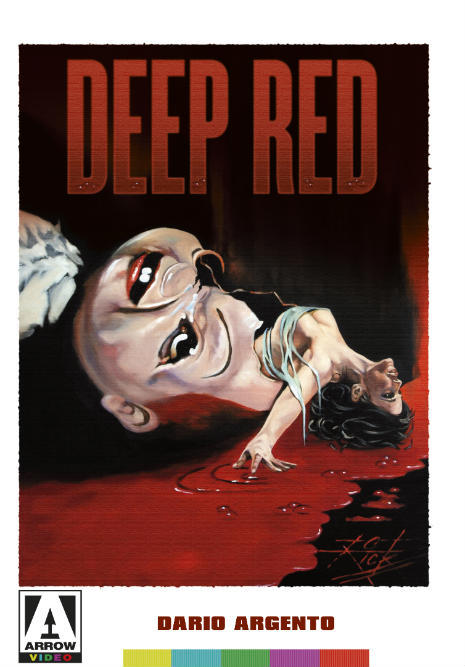
So the thing is, Dario Argento is an artist who, in spite of his notable misanthropy, has given something to the world. He works in what I would call the most complex artistic medium in human history, and for more than a decade, he consistently lives up to its many intricate challenges. Here you have a guy who wakes up one day and says, "You know, I have something to say. I see the world in a certain way, and I need to tell everyone about it. I'm going to shoot a movie that's really going to make people feel something." And he does. He makes PROFONDO ROSSO, a perfect film. He really cares about it. Every single thing is just so. He takes these absurd miniature tableaus, and photographs them in a way that transforms them into another universe. He makes you feel like you're seeing the color red for the first time. He positions flashy modernity against grave antiquity, and seductive trash against high art, creating juxtapositions that communicate vividly about the dazzling contradictions in the very soul of Rome. This dichotomy is mirrored in his main character, a nervy but vulnerable pianist who has to hide his full artistic sophistication, lest he lose his job playing in seedy dives. This being a giallo, he witnesses a mysterious murder, the key to which is buried in his own memories--he himself becomes the only substantial evidence of the crime, and he is forced to live out his life in an escalating nightmare until he gathers enough context to make meaning out of what he knows. PROFONDO ROSSO is indeed profound and savage, offering reflexive commentary on its own existence as a primal and salacious piece of entertainment that is executed with almost impossible elegance and wisdom. Dario Argento is an artist who recognized the full multifaceted power of cinema, and then with great deliberation, fashioned this gift to the world.
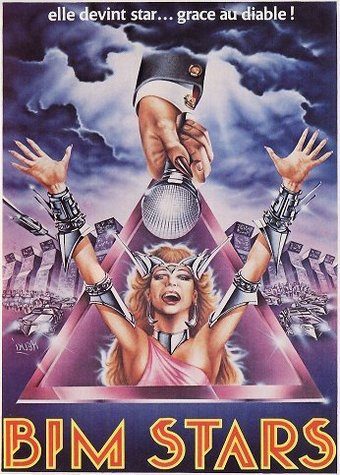
Meanwhile, this same world also contains a guy like Menahem Golan. Golan may be forgivable as the crass commercialist behind the Cannon Group, who shat out a number of dusty-looking vehicles for goons like Chuck Norris and Sylvester Stallone. However, nothing forgives THE APPLE. Nothing even explains it. It appears to be marketed to no one at all, being that no human being who has ever walked the earth could derive pleasure from it. While it may be hard to imagine possessing Argento's talent, it's easy to imagine him contemplating the vast potential of cinema, identifying its prismatic means of expression, and approaching it with both the humility and the courage to make of it something flawless. He does due diligence. He is responsible. He may injure his audience with his brutality, but he’ll never hurt their eyes. It is in no way so easy to even begin to estimate what Menahem Golan was thinking when he dreamed up this grueling fundamentalist christian sci-fi fantasy in which a pair of dopey Adam and Eve-like folk singers tries to save the distant future of 1994 from a literal disco inferno. This dystopian fable, apparently shot in the mass transit hubs of West Berlin, describes a world that has been taken over by a tyrannical music production company-cum-government, Boogalow International Music. The defining characteristic of its rule is enforced disco dancing. The viewer will never find out what is gained by all this disco dancing, or what else this company/government does; there is almost no apparent violence, physical or institutional, and there seem to be no consequences for the disco-averse other than that they are occasionally fined for failing to wear their "BIM marks" (a sort of "mark of the beast" that's obviously just a dead stock skate sticker). BIM's worst crime is trying to turn cherubic hippie chick Bibi into a disco diva, while keeping her apart from her beloved folksy musical partner Alphie. The action culminates with the lovebirds running away to live with a bunch of dirty hippies who leave unattended fires burning all over the public park where they live, and who are presently rescued by a godlike intergalactic being (or just god, but he flies around in outer space, I have no fucking idea) in a white tuxedo, who ferries them all off to another planet in his flying Rolls Royce.

That is how THE APPLE resolves itself. It's almost a feat in and of itself that, in spite of being based so transparently on the story of the Garden of Eden and certain parts of the Book of Revelations, THE APPLE manages to have no clear message whatsoever. There's a tenuous thing about how it's good for people to love each other, but it's impossible to imagine what BIM's point is, why they care whether or not people love each other, why they oppress people, how they oppress people, and what happens if you defy them, other than that you get a ticket and someone chases you out of the civic space that you're vandalizing. Besides that, the movie is simply bad in every single way. The music is the worst you'll ever hear, vacillating between being purely idiotic, and being militantly offensive, as in the case of a reggae number comparing the rule of BIM to the American slavery period. The costumes are beyond ugly, leaving every single character looking like they've been scribbled on and thrown in the garbage by an angry child. At a certain point, THE APPLE seems to be meticulously checking off a list of things that no person would ever wish to see in a movie, from filthy gangs of sack-clad children shrilly repeating nonsense lines, to warty old jewish stereotypes being sexually molested while they spoon-feed unctuous folk singers a greasy-looking stew
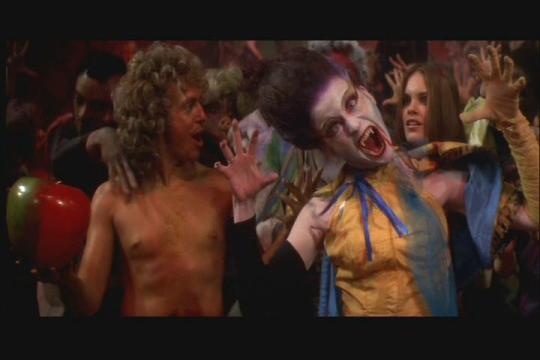
The film is so hideous in every dimension that you wouldn't even take a picture of it if it were happening in front of you. It's bad enough that the people who collaborated on this movie actually did any of what you see on the screen even one single time, without someone actually deciding to record the whole thing and distribute it to the world at large. What I'm essentially trying to say is, on the same planet in the same timeline, you can somehow have a person like Dario Argento, considerately and patiently crafting an incomparable work of art that speaks to the artist's economic and historical context--and you can also have someone like Menahem Golan, who can't even figure out how to make meaning out of the fucking Bible, who has the fucking nerve to shoehorn a bunch of degenerates into grimy leotards and make them twirl batons in a world covered in shitty stickers, and he calls that a fucking movie. He charges money for people to see it. It is literally maddening to even try to imagine what would motivate all this wasted motion, the product of which is so aesthetically and emotionally destructive that it is actually evil. It can be evil, to make a bad movie. This is the one and only lesson of THE APPLE.
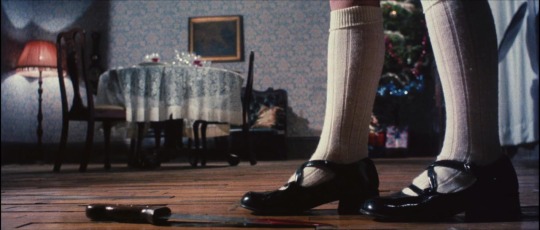
PS I've seen THE APPLE like a hundred times so I guess I actually love it in some perverted way, I mean I'm not above it. Just, something had to be said.
#blogtober#deep red#the hatchet murders#profondo rosso#dario argento#the apple#men ahem golan#menahem golan#musical#sci-fi#fantasy#religion#giallo#horror#thriller
18 notes
·
View notes
Text
Interview: Ted Raimi (Ash vs Evil Dead, Evil Dead II, Darkness Rising)
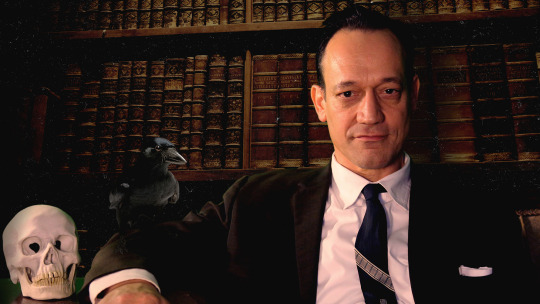
Cult actor Ted Raimi discusses his new film, Darkness Rising, which hits select theaters and VOD on June 30. He also talks about the 30th anniversary of Evil Dead II and his recent return to that universe on Ash vs Evil Dead. Perhaps most exciting, Raimi reveals exclusive details about his upcoming feature directorial debut, a psychological horror film titled The Seventh Floor.
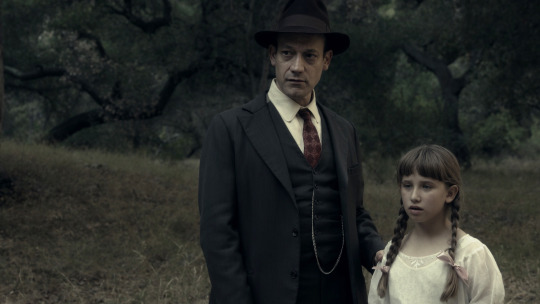
Can you begin by telling us a little bit about Darkness Rising and how you got involved?
Darkness Rising was a good script. A friend of mine, Austin Reading, directed it. We've worked together in the past on a few things, and he’s a good director. He asked me to do a cameo in it. Normally I don't do those, but I really liked the script, and I like Austin's directorial style too, so I said yes. It's a good, spooky haunted house movie. There's a lot of those, but I think this one's unique. The cameo that I do is a period piece, so that made it doubly interesting.
I'm sure you get approached for horror movies all the time. What attracts you to a particular project?
Any number of things. Artistically, if it's something that hasn't really been done before. Haunted houses are certainly nothing new, but it's how this one approached that was very original and great. Typically, if they're not friends handing my scripts like Austin did, they need to get you on a scary level that is a genuine fright. Cheap scares are easy. Monsters popping out of the darkness is a simple thing to do. Jacques Tourneur, this American director who pioneered that, has been imitated so many times we've forgotten where it originally came from.
That said, things that really scare me I love to consider. For example, one of my favorite horror moments of all time is in a movie that is mostly terrible: The Amityville Horror. It's a dreadful movie; I'm not a fan of it. But there's a scene where the guy who wants to buy the house goes to the bank and get gets like $78,000 in cash - remember, this is the '70s - and he puts it in the library. He walks next door to talk to the owner and says, "I'm ready to make you an offer." Then he walks into the other room and the money is gone. That is absolutely frightful. Your whole life is gone. Your family is in trouble. That's true terror. If scripts can approach something in that manner, that excites me.
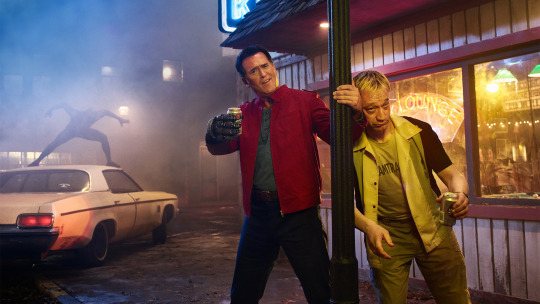
You appeared on Ash vs Evil Dead last season. How did it feel to return to the Evil Dead universe after all these years?
It was fantastic! It was like a high school reunion, but with new kids that I hadn't met yet. All my old pals were there - Bruce Campbell and Lucy Lawless and a lot of the crew and the producer, Robert Tapert - but then there's these new guys, played by Ray Santiago and Dana DeLorenzo. Those guys are just tremendous! They're like the next generation of Ash. It was great to work with everybody. And I got to put the monster suit back on, for better and for worse, as well playing Chet Kaminski.
What was it like to get back in that Possessed Henrietta costume?
Trepidatious, but glad I did it! There's a new team in New Zealand that recreated Mark Shostrom's amazing original creation along with the guys from KNB special effects. They did a good job. It was challenging. It was still just as hard as it was 30 years ago, but I'm glad I did it. It turned out good, and we had a good time making it. Bruce and I were there again, 30 years later. It was the weirdest deja vu. The cabin was the same, we were in the same costumes. It was like we had gone forward in time 30 years. Usually you want to go back, but we went forward. It was weird!
Was it strange to be on an Evil Dead set without your brother Sam Raimi in the director's chair?
No, not at all. It's still his vision, but now there's new directors that have their own vision to add to it. It makes it very refreshing.

This year marks the 30th anniversary of Evil Dead II, which remains one of the best horror sequels of all time. How do you feel reflecting back on that time in your life?
Good! That was my Screen Actors Guild card intro. In those days, you had to have a line in a feature film that was also Screen Actors Guild, so I agreed to do that movie. I thought, "This will be an easy way to get my SAG card." But it was, in fact, that hardest way I could have ever done it. It was the equivalent of, say, there's a train that goes underneath the Alps from Italy to Austria. You can take this train. Alternately, you can hike the Alps all by yourself in bare feet. And I went, "Oh, I guess hiking the Alps in bare feet must be the way to go!" So that was that.
You voiced two characters on Buddy Thunderstruck for Netflix. What was that experience like?
It was great. Those guys at Stoopid Buddy Stoodios are terrific, immensely talented. That show was written by a guy named Tom Krajewski, who really wrote some fine episodes and very funny dialogue. It was great, because it’s stop-motion animation and all done in Burbank, California. Normally, these days cartoons are all outsourced to India, China, places like that, but this was done frame-by-frame in Burbank, just like Disney used to do in the '20s. It was cool. I really felt like I was working on something iconic. I thought it turned out very good.
Plus, it's nice to do something that's kids-friendly for once in my life. Usually, everything I do you can't show kids - except for maybe a couple of Spider-Man movies, and even those are a little scary for the young ones. I've got cousins and nieces and nephews that can actually watch something I did, as opposed to, "Well, when you're a little older, you can watch Uncle Ted's stuff!" [laughs]

I know it's early, but have you heard anything about a second season of the show?
I haven't yet, but Netflix is very, very quiet about their shows. We can't get a peep out of them. I think it has something to do with how they aggregate their ratings; I don't really understand it. I have not heard anything, but it certainly seems to be a popular show. Fans approach me about it when I go to conventions. It was a lot of fun. I was very grateful to have done that. It's nice to not shave and get in a booth and drink coffee and do your lines. It's incredible that you don't have to go to set and do all that stuff. It was fun.
As someone with your longevity in the industry, do you have any advice for upcoming filmmakers or actors?
Always try to make the make the greatest movie you possibly can. Don't make an okay movie just to make a movie. There's enough crap out there, and your movie will get lost, and you will be known as a mediocre filmmaker. Make the greatest movie you can. If it falls flat on its face, well, at least you tried.
One other piece advice: don't ever try to be a cult filmmaker or cult actor. The audience decides that for you. There's nothing you can do about that. A lot of people have tried to be a cult actor but failed in one way or another. Some actors desperately try to be as strange and as outlandish as possible. It's not that they're bad actors, but it's not up to you. I tried to do the best I could, thinking I was a pretty straight-ahead actor, and all of a sudden I was a cult actor and doing conventions and all that.
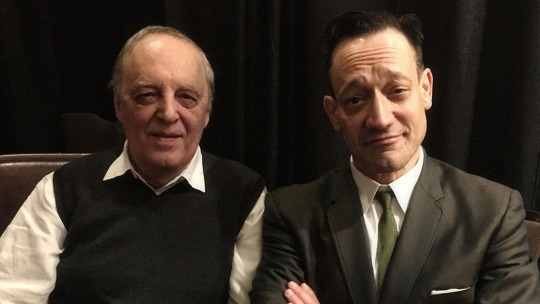
Speaking of conventions, what are those like from your perspective?
It's a wonderful thing. You get to meet fans. When you do movies and especially television, which I've done so much of, the best you can hope for is to sit in your living room with some of your friends, drinking booze and having a laugh, and then it's all over and everyone goes home. But when you go to conventions, you get to meet the thousands of fans that go to these things, and you say, "Oh, my God! All you guys watch it, too? That's awesome!" And I'm a fan myself. Most actors go to those things I think because they have to, but on the last day I'm there I'll close up shop early from shaking hands and doing panels and stuff, and I'll go walk to the floor. I love to see all the cool stuff, because I really love horror.
Are there any celebrities who you were really excited to meet at a convention?
Are you kidding? Yeah! I don't really care about autographs personally, but I've met some icons. I just met Dario Argento. It was insane meeting him. When he was alive, I met Jonathan Harris. I used to watch re-runs of Lost of Space when I was kid, and Jonathan Harris played Dr. Smith. He was awesome, an old Shakespearean actor. Also Malcolm McDowell and other guys who I always loved as a kid, thinking, "I'll never meet him," but I've finally met them all. They were were awesome and great inspirations. Also a lot of directors, like Dario and John Carpenter, who I first met at a convention and have since spoken to many times. It's a wonderful thing. And now I'm one of them! These young actors go, "I've seen you in so many things since I was a little kid!" So I guess I'm like one of those guys I used to admire when I was kid. It comes around, and that's a good thing.
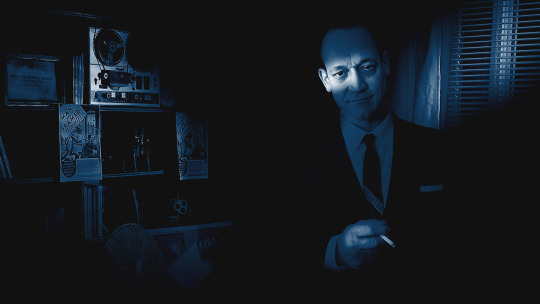
You've worked with so many great filmmakers - not only Sam, but also the likes of Wes Craven, Bernard Rose, William Lustig, Takashi Shimizu, to name a few - and I know you've done some shorts of your own. Have you ever thought of directing a feature?
Yes, I'm directing my first feature this year, as a matter of fact. It's called The Seventh Floor. Veva Entertainment is producing it, and we're pre-pro now. We don't start shooting until September, at the moment. It's a thriller. I can't tell you what it's about, but it's psychological horror. I'm very excited about that. It's not traditional horror; there's no monsters or zombies or anything like that. It's more in your head.
And this year I created a campaign for the Starz network, which was a really wild experience. If you look online, it's called the Shemps Beer ad campaign. I created it when I was shooting Ash vs Evil Dead, so it was wonderful. Rob Tapert gave me a nice chance to work with Starz, so I made this for their online presence. It was really fun. I didn't know I'd also like advertising. It's the same old story that motivational speakers always tell, but it's kind of great. Somebody says to a kid, "You like playing the trombone?" Kid says, "I don't know, I never tired it." So I tried to be an ad man, and I wound up really like it. It’s odd.
I know you can't give away any details, but are there any particular films or directors you're drawing inspiration from before you get behind the camera on your first feature?
For this one, Roman Polanski and Dario Argento. Both of those guys are incredibly influential; Roman Polanski for his ability to build tension where there seemingly is none, and Dario Argento for his filmmaking style and the speed at which the action happens. It's unbelievable. I've studied them to get a sense of it. I'm also heavily inspired by David Cronenberg. He for the same reason that I like Polanski. He's able to create such amazing moments where there is no action, but you sense a palpable tension.
If you think of Cronenberg’s remake of The Fly, you think about Jeff Goldblum transmogrifying into the insect. But if you watch the first act, there's a scene that lasts about 10 minutes where Jeff Goldblum is talking to Geena Davis in his laboratory, which is in this warehouse. Nothing happens. There's just dialogue, and yet there's something so fearful about the whole thing. It's the greatest magic trick any director has ever done. I don't know he did it. There's no spooky music or spooky camera moves, and yet it's absolutely frightening. I'm still trying to figure that one out. I've watched that first act probably six times trying to get it, but I can't. If I can recreate that to some degree, I'll be a very lucky director.

I have to say, I was excited to learn that you're getting behind the camera, but to hear you mention Polanski, Argento, and Cronenberg as influences, I really can't wait to see it.
Thank you! That's a nice compliment. You really seem to know your stuff! You really did your research.
Do you have any other upcoming projects we should be on the lookout for?
No, just that movie. It's keeping me very busy. That, and a pipe broke in backyard, so I've got to take care of that. That's on a personal nightmare note. [laughs] Normal crap happens to Hollywood people too, just in case anyone's wondering! Fans think it's funny. They see you on TV a thousand times, and they don't know that you also go to Trader Joe's and 7-Eleven. They're like, "You do?" And I'm like, "Yeah, do you think everything magically appears in my house?" Nope! [laughs]
#ted raimi#ash vs evil dead#ash vs. evil dead#evil dead 2#evil dead ii#darkness rising#interview#article
41 notes
·
View notes
Text
[Exclusive Interview] LUZ Director and Producer Talk Inspiration And The Power of The Supernatural
The German possession film Luz celebrated it’s North American premiere July 20, at the the 2018 Fantasia film festival. Writer/Director were welcomed by a sold-out crowd eager to see their fresh take on the possession sub-genre.
Luz is an experimental film that follows a young cabdriver on the run from a demonic presence. After running for safety into a police station, she is placed under hypnosis for in-depth interrogation, slipping in and out of different memories as they are recalled. Shot on 16mm, Luz is a darkly beautiful film that perfectly captures an authentic 80’s aesthetic. It is a strong debut from talented filmmakers that have crafted something I will not soon forget.
We had a chance to sit down and chat with writer/director Tilman Singer and producer Dario Mendez Acosta after the film’s premiere to discuss hypnosis, horror movies (and surprisingly), Ari Aster’s Hereditary.
Nightmare on Film Street: [Luz] is a really interesting take on the demonic possession. Are you guys big fans of that genre?
Tilman Singer: I cannot say I am. I mean, I’m a big fan of movies like Possession and The Exorcist, of course but I don’t even know how many possession movies I’ve seen. It just came naturally over research because I was researching hypnotherapy, hypnosis, interrogation and questioning which is so suggestive that you cannot really find the truth when you question somebody. But it became a very clear tool for an evil entity in the movie. It was very devilish, you know, using hypnosis for bad. To manipulate somebody.
[…] People ask me, what were your influences? And of course, I am in love with Dario Argento movies and stuff like that but a lot of that were like, practical decisions that came to bit by bit. That it was a possession movie came later after I had a vision of that whole interrogation scene. And I thought I would be so great if it’s supernatural because hypnosis is something scary, kind of messing with somebody’s head.
NOFS: I wanted to ask you about the run-time. It’s quite a bit shorter than than I thought it would be. I didn’t know that going in, so I and I didn’t feel like we were missing anything. I was curious if you just wrote it that way and said ‘there’s nothing else we need to add to this’ or if it was just something that happened in editing.
TS: Pretty much. The plan wasn’t to write a feature from the beginning since this is our thesis. I just knew I wanted to write something longer, to try out a little longer form of storytelling than we did before. I was aiming for, like 30 minutes. But then the story got so convoluted that you can’t tell this in 30, and became more and more and more, and we just ended up at 70 minutes.
NOFS: What did that original 30 minute short look like?
TS: Pretty much just the interrogation, I’d say. And then the whole backstory of the character of Luz and her schoolmates and where she’s coming from, that I put on top on that interrogation. So there had to be like, kind of a foreplay and an aftermath. I think somebody called it a “long short” because it kind of is, you know? she’s entering the police station, and she’s leaving. It’s kind of a typical short movie narrative where you have one action you’re telling. Like, one visit to the store or visit to the police station and when she’s going out, movie’s over.
[…] After I knew, okay, this is gonna get a little bit more longer, and now I’m at like 40 minutes, but I still have a story to tell, I’m not done. I thought to myself, okay, I should at least go over 60, because that is like the threshold for festivals, for calling it a feature, for most of them to be accepted. So, I was going for it but then it naturally becomes 70 minutes.
And since we didn’t really think of distribution as a thesis, I just didn’t care. And also, I mean, we shot on film and we really did the math on it. We bought exactly as much reels as we ended up shooting. Like, we had half half a reel left or something at the end.
NOFS: So, a lot of this was done on first take?
TS: No, well there were some first takes but when you shoot film, it’s always good to have a second one because maybe there’s some kind of hair somewhere, even though you check of course. We have three takes in general. I don’t do rehearsals in advance. I do it all on set to get the tension and then you rehearse, rehearse, rehearse, and when you think, okay, now the energies, right, I think the next take will be the best that you have so far. And we’re on the energetic level and then we shoot. It’s so much fun.
NOFS: How was the screening last night? I was really glad to see that you guys sold-out.
TS: That was really nice. It was a really relaxed and nice screening. We had super good feedback and it was really sad to see people get turned away. They tried to fill up every possible spot but there were still people waiting. I even offered them my spot because I’m not really watching it anymore. […]And since I edited it myself, nowadays I just see like, oh this should have been shorter, this should have been longer.
NOFS: How was the reception? How did the audience like it?
TS: I think they liked it very much. You know, I always do Q&A’s after, and I enjoy them always but I’m always a little bit shy. Last night I was a little bit stoned and I [asked] them “How did you like it”? And of course as like an audience, all of them getting requested and people were like “Oh, yeah, it was good”
Dario Mendez Acosta: But I think it’s also a bit heavy for them because it’s always, “Yeah, I liked it but I don’t think I got everything”.
TS: And sometimes I don’t even watch Q&A’s. We watched Hereditary and Ari Aster, the director, was there but I did not want to talk about what I just saw. I just wanted to leave.
DMA: I was all in. I wanted to question him
TS: Yeah, you wanted to question him but I was like, ‘No, I don’t want this’, and I wanted to be with myself and like sort that shit out, you know?
DMA: And I was too scared. I don’t want to be alone. I’m there where the most people are
NOFS: It’s weird how many people didn’t like that movie [but] I really want a slow, low-key scare and I think that’s what you’re doing with Luz as well.
TS: Yeah, there’s no jump scares. Just a progression into more and more creepiness.
NOFS: So, you said you don’t watch a lot of horror movies?
TS: No, I do, I do. When I was a child I remember clearly I remember the time I was too young to watch horror movies. My parents didn’t let me but I was obsessed with like monsters and scary stuff and violence as a child and I remember my grandmother taking care of me for like two weeks when my parents were on vacation and I forced her to tell them the all the scary movies she’d seen in her life. And she hadn’t. I think she just made up movies and I have some kind of werewolf story in my head that my grandmother clearly came up with because I tried to find it online and it does not exist the way she told it. But yeah I remember I fought my parents to finally even watch things like Jurassic Park. I remember I was too young to see Jurassic Park and then I could and it was awesome and scary!
DMA: I’m not good for watching horror movies and, also all this new stuff, this jump scare stuff. This is not working for me and also, I don’t want to be scared but with Hereditary it’s just like it’s something happening there. It’s magical for me and when I asked him like I wanted to know his influences but also different artists to see [more diverse] art than just movie art. And he totally did that. He told me about like several photography artists and it’s interesting to me because I use this also for inspiration.
Tilman showed me a lot of old movies that I should watch that I should know for working on [Luz], like Suspiria and it was really helpful because it was like ‘oh man, it’s like all copper’ or whatever and it’s like ‘oh, you can do this,’ and it’s fine super freeing for me like oh yeah, thank you. I’m going to do that, thsi is really awesome. In general, like, horror movies, I don’t know. I don’t like to be scared, but you have this magic on me working. This is awesome.
TS: For me it’s not really the scare or the horror, or the terror of it, it’s just- you know, you’re always looking for some kind of conflict and it comes natural with a horror movie or with a supernatural movie, and I like a supernatural element as a standard for something that might be concrete but you don’t want to put it into words. Like, I don’t know incest or rape you can just have a monster symbolically there for it and you can actually talk to more people and give them a safe space to enter, a space like this. For me because it’s so abstract, and then it really touches me emotionally because even though it’s more abstract, it’s about a monster or it’s about the devil or about anything, I don’t get so distant.
NOFS: It gives you the ability to talk about it without feeling like you’re going to close to it. to close yes
TS: Yes, I think that’s what I like about horror movies
Luz celebrated its North American premiere at the Fantasia Film Festival in Montreal on July 20th and was recently acquired by Yellow Veil Pictures. Read our full review of Luz HERE.
Check out more of Nightmare on Film Street’s Fantasia Fest Coverage here, and be sure to sound off with your thoughts over on Twitter and in our Facebook Group!
youtube
The post [Exclusive Interview] LUZ Director and Producer Talk Inspiration And The Power of The Supernatural appeared first on Nightmare on Film Street - Horror Movie Podcast, News and Reviews.
from WordPress https://nofspodcast.com/luz-fantasia-interview-tilman-singer/
via IFTTT
0 notes